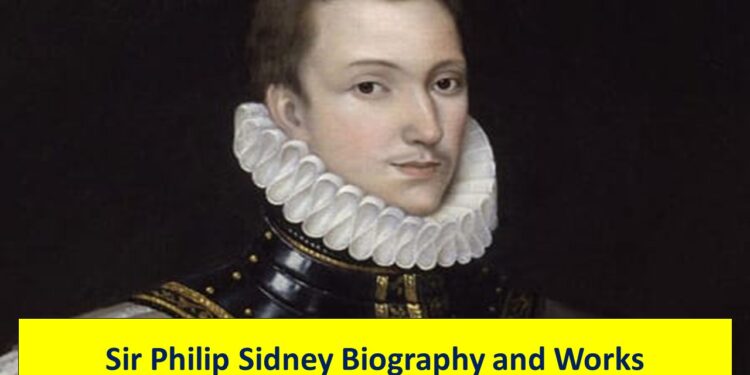- Astrophel and Stella (1580): A groundbreaking sonnet sequence, “Astrophel and Stella” is considered one of the earliest and finest examples of the Petrarchan sonnet form in English literature. Comprising 108 sonnets and 11 songs, the work explores themes of unrequited love, desire, and the complexities of romantic relationships. The title characters, Astrophel (meaning “star-lover”) and Stella (meaning “star”), serve as symbolic representations in the poems.
- The Defence of Poesy (also known as An Apology for Poetry) (1595): In this influential prose work, Sidney provides a robust defense of poetry against contemporary criticisms that questioned its moral and intellectual value. He argues that poetry, far from being an inferior or corrupting art form, has the power to inspire virtue, elevate the human spirit, and convey profound truths. “The Defence of Poesy” is a significant text in literary criticism and a testament to Sidney’s commitment to the value of literature.
- Arcadia (completed in the 1580s, published posthumously in 1590): “Arcadia” is Sidney’s pastoral romance, written in prose and interspersed with poetry. The work presents an intricate narrative of love, adventure, and political intrigue set in an idealized pastoral landscape. Although the work was left incomplete at the time of Sidney’s death, it was posthumously published and became immensely popular, influencing later writers in the pastoral genre.
- Psalm 43 in the Sidney Psalter (1599): As part of his broader contributions, Sidney translated the Psalms into English verse, known as the Sidney Psalter. This translation aimed to make the Psalms more accessible to English readers and reflected Sidney’s religious convictions. Psalm 43 is one of the notable pieces in this collection.
Marriage and Family:
Sidney wed Frances Walsingham in 1583. Frances was the daughter of eminent statesman and spymaster Sir Francis Walsingham. Despite the fact that Sidney and Frances’ marriage was arranged and might have had political undertones, there is evidence to suggest that they grew to love one another sincere. Due to his military and diplomatic responsibilities, Sidney’s time with his family was restricted. Nevertheless, the couple did have a daughter, Elizabeth, who was named after Queen Elizabeth I.
Literary Legacy:
- Pioneering Poetry: Sidney’s “Astrophel and Stella” is celebrated as one of the earliest and finest examples of the English sonnet sequence. His exploration of unrequited love and the blending of Petrarchan and Elizabethan sonnet forms set a precedent for later poets.
- Defender of Poetry: “The Defence of Poesy” remains a cornerstone of literary criticism. Sidney’s eloquent defense of poetry as a moral and didactic force has shaped perceptions of the art form and continues to be studied in the context of Renaissance literary theory.
- Pastoral Tradition: Sidney’s “Arcadia” contributed significantly to the pastoral tradition. Its influence extended to later works in the genre, including those of William Shakespeare and Edmund Spenser.
Conclusion
Sir Philip Sidney Biography and Works-As a prominent figure of the Elizabethan age, Sir Philip Sidney had a profound impact on politics, literature, and English culture in the sixteenth century. Despite being tragically cut short at age 31, his life served as a testament to the ideals of the Renaissance, a time marked by the pursuit of virtue, artistic exploration, and intellectual fervor.
Sir Philip Sidney Biography and Works-The groundbreaking sonnet sequence “Astrophel and Stella,” which explored the intricacies of love and desire, is a prime example of Sidney’s literary legacy. “The Defence of Poesy,” his masterwork of prose, helped to shape Renaissance literary theory in addition to defending the merits of poetry. “Arcadia” demonstrated his narrative prowess in the realm of fiction and contributed to the growth of the pastoral tradition.
Sir Philip Sidney Biography and Works-Beyond the realm of literature, Sidney’s military heroism in the Battle of Zutphen elevated him to the status of a national hero. His commitment to chivalric ideals and service to Queen Elizabeth I marked him as an embodiment of the Renaissance courtier. His diplomatic contributions further demonstrated his intellectual acumen and political insight.
Sir Philip Sidney Biography and Works-Sidney’s legacy extends to the cultural and religious spheres through his translations in the Sidney Psalter and his influence on the educational curriculum of his time. His image and ideals persisted, influencing later writers such as Shakespeare and Milton.
While his later years were marked by personal struggles and the complexities of courtly life, Sidney’s enduring impact lies in his ability to navigate the intricate intersections of literature, politics, and personal conviction. His life reflects the tensions and aspirations of an era on the cusp of transformation.
Sir Philip Sidney’s legacy endures not only in the pages of his works but also in the broader cultural consciousness. His contributions continue to be studied, celebrated, and admired, ensuring that the Renaissance ideals he championed remain alive in the annals of literary and historical heritage.

















